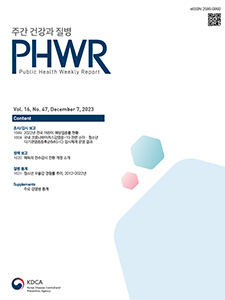Current Issue
Vol.16 No.47, December 07, 2023
-
Surveillance Reports 2023-12-07
 3
3
 549
549
 369
369
National Childhood Vaccination Coverage among Aged 1-3 and 6 Years in the Republic of Korea, 2022
Jae-Young Lee, Seunghyun Lewis Kwon, Hyung-Min Lee
Public Health Weekly Report 2023; 16(47): 1589-1603 https://doi.org/10.56786/PHWR.2023.16.47.1 Abstract
AbstractThe most cost-effective way to prevent vaccine-preventable diseases is to set and maintain vaccination coverage level above the herd immunity threshold for disease transmission prevention. In the Republic of Korea (ROK), the government is implementing policies to achieve immunization coverage of over 95% through routine immunization guidelines and activities, such as the National Immunization Program (NIP) for free since 2014. The national vaccination coverage serves as an important indicator of the NIP’s effectiveness. Since 2015, the Korea Disease Control and Prevention Agency has been publicly reporting the national vaccination coverage levels. This report presents the main results of the national childhood vaccination coverage rate for 2022, which includes 1.2 million records of children aged 12 months (born in 2021), 24 months (born in 2020), 36 months (born in 2019), 72 months (born in 2016). The overall vaccination coverage rates for respective age groups in 2022 were 96.1%, 93.5%, 89.7% and 88.6%. Additionally, this report provides sub-national results of vaccination coverage rates and suggests future directions. The ROK’s vaccination coverage exceeds that of many advanced and developed countries. Although the ROK has been maintaining a high-level vaccination coverage rates, there are differences in vaccination coverage rates by region or some vaccines. Thus, further investment and research are required to address issues such as vaccine hesitancy, vaccine refusal, the anti-vaccine movement, and vulnerable social group.
-
Surveillance Reports 2023-12-07
 1
1
 381
381
 141
141
Results of the Coronavirus Disease 2019-associated Multisystem Inflammatory Syndrome in Children (MIS-C) National Surveillance System in Republic of Korea
Hye Rim Park, Yeon Haw Jung, Mi Yu, Hye Young Lee, Hye-jin Kim, Hee Kyoung Kim, Sang-Eun Lee, Hyeokjin Lee, Eun-Jin Kim, Hyungmin Lee, Jungyeon Kim
Public Health Weekly Report 2023; 16(47): 1604-1619 https://doi.org/10.56786/PHWR.2023.16.47.2 Abstract
AbstractMultisystem inflammatory syndrome in children (MIS-C), a severe complication of the coronavirus disease 2019 (COVID-19), similar to Kawasaki disease, has been reported in the United States and Europe, with the World Health Organization calling on clinicians worldwide to be vigilant for MIS-C. In response, the Korea Disease Control and Prevention Agency operated a prospective surveillance system from June 2020 to April 2023 to assess the incidence and level of MIS-C associated with COVID-19 in the Republic of Korea. With the nationwide cooperation of pediatricians, a total of 180 suspected cases were reported. After review by the Case Assessment Committee, 146 cases were confirmed to be consistent with MIS-C, with no fatalities reported. The establishment of a prospective surveillance system for MIS-C and securing basic data, such as clinical information and epidemiological characteristics of domestic cases through national-level operations, is important as part of the preemptive prevention policies in response to COVID-19. Establishing a diagnostic system in preparation for the anticipated transition of COVID-19 patients into the general healthcare system, with the expectation of continued spread and endemicity, ongoing attention and further research are necessary to ensure timely diagnosis and treatment in clinical practice.
-
Policy Notes 2023-12-07
 2
2
 599
599
 166
166
Introduction to the Transition of Mandatory Surveillance System in the Syphilis Monitoring
Seongjin Wang, Seonja Kim, Sangsik Cho, Hwa Su Kim, Seonyeo Min
Public Health Weekly Report 2023; 16(47): 1620-1630 https://doi.org/10.56786/PHWR.2023.16.47.3 Abstract
AbstractAs of October 2023, syphilis is a class 4 infectious disease under a sentinel surveillance system. It will be converted to a class 3 infectious disease subject to the mandatory monitoring system from January 1st, 2024. Syphilis is a disease that should take into account the continuity of prevention, diagnosis, treatment, and chronic care management due to the high risk of infection, severe complications, long-term transmission, increased economic and psychological burden from follow-up and continuing occurrence. In the current sentinel monitoring system, it is difficult to understand the overall occurrence situation due to the unavailability of the epidemiological information. Through the transition to the mandatory monitoring system, we can collect the epidemiological data that can describe the trends in the prevalence to promote the prevention and control of syphilis.
-
QuickStats 2023-12-07
 1
1
 166
166
 275
275
Trends in the Prevalence of Perceived Depressive Symptoms among Korean Adolescents, During 2012–2022
Public Health Weekly Report 2023; 16(47): 1631-1632 https://doi.org/10.56786/PHWR.2023.16.47.4

pp. 1~2097
Most Keyword
?
What is Most Keyword?
- It is the most frequently used keyword in articles in this journal for the past two years.
Most Read
-
Waterborne and Foodborne Disease Outbreaks in the Republic of Korea, 2023
Myung-Jae Hwang, So Yeon Park, Hyungjun Kim, Se Jeong Yang, Sungchan Yang, Jin Seon Yang
Public Health Weekly Report 2025;18: 17-32 https://doi.org/10.56786/PHWR.2025.18.1.2 -
Implementation Plan for the Coronavirus Disease 2019 Vaccination for the 2024–2025 Season: Recommendations of the 6th Expert Committee on Immunization Practices
Hyewook Hwang, Wookeon Lee, Seohyeon Ahn, Young-Sook Choi, Seunghyun Lewis Kwon, Dongwoo Lee, Eun Hwa Choi, SokGoo Lee
Public Health Weekly Report 2025;18: 90-102 https://doi.org/10.56786/PHWR.2025.18.2.3
Editorial Office
+82-43-719-7569





 Full Text
Full Text Cite
Cite


